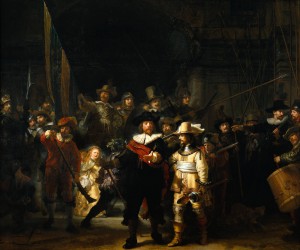Dutch scientists have made a fascinating discovery through meticulous tests on Rembrandt’s masterpiece The Night Watch. They have concluded that the artist likely had access to materials previously thought unavailable in seventeenth-century Amsterdam, a revelation that challenges our understanding of Rembrandt’s palette and techniques.
The Night Watch, one of Rembrandt van Rijn’s most iconic paintings, is undergoing a thorough restoration process. This enormous group portrait, created in 1642, was initially thought to depict a night scene, a misconception due to a layer of dark varnish that was not removed until the 1940s. The current restoration efforts, known as Operation Night Watch, began in 2019. In a novel approach, the Rijksmuseum in Amsterdam has transferred the painting into an enormous glass enclosure, ensuring that specialists can access the painting without removing it from public view. Operation Night Watch aims to fully document the restoration, mapping out the entire painting bit by bit to gain a comprehensive understanding of how Rembrandt created it. In this process, specialists have discovered where the paint has specifically discolored, the locations of the canvas’s deformations, and elements that are now missing from the present work. Most recently, however, chemists have found that Rembrandt used specific varieties of pigments previously thought unavailable to him.
Fréderique Broers and Nouchka de Keyser, PhD students at the Van ’t Hoff Institute for Molecular Sciences at the University of Amsterdam, worked alongside Rijksmuseum specialists in detecting the presence of sulfur and arsenic in some of the pigments. They were found specifically in the detailing for one of the painting’s main figures, Lieutenant Willem van Ruytenburch. After detecting arsenic in the paint, they initially concluded that Rembrandt likely used realgar and orpiment pigments for his red and orange-yellow paints. However, after further analysis, they found something more interesting. The actual pigments used were more unusual, as they contained pararealgar, which is a yellow pigment, and semi-amorphous pararealgar, which is more orange-red. Normally, that would not be interesting as realgar degrades into these compounds as it ages. But since the paint seems unaltered and both pigments are distributed rather evenly, the specialists concluded that Rembrandt had intentionally used pararealgar and semi-amorphous pararealgar to achieve the sort of shimmering gold effect found in the detailing of Van Ruytenburch’s coat. At the time, pigment manufacturers and vendors could synthetically create these pigments by treating naturally-occurring mineral realgar through sublimation. Because of this process and the fact that the materials were imported, these pigments were rare in seventeenth-century Dutch paintings. Researchers first picked up on the presence of these compounds in 2021, but they have finally published their complete findings in the journal Heritage Science. According to the report, “A comprehensive review of historical sources gives insight into the types of artificial arsenic sulfides that were available and suggests that a broader range of arsenic pigments could have been available in Amsterdam in the seventeenth century than previously thought.” The team also tested paintings by Rembrandt’s contemporaries to see if they could detect pararealgar. Eventually, they detected pararealgar in the Willem Kalf still-life painting Still Life with a Silver Jug and a Porcelain Bowl.
Arsenic sulfides have been previously found in several Rembrandt paintings, including The Jewish Bride. However, they have never been commonly associated with the artist’s palette. Their presence in The Night Watch shows these pigments’ intentional use and may lead to further studies into several subjects. These include the availability of certain colors to Dutch Golden Age artists, how these painters consciously used color, and the seventeenth-century world’s interconnectedness through commerce.

